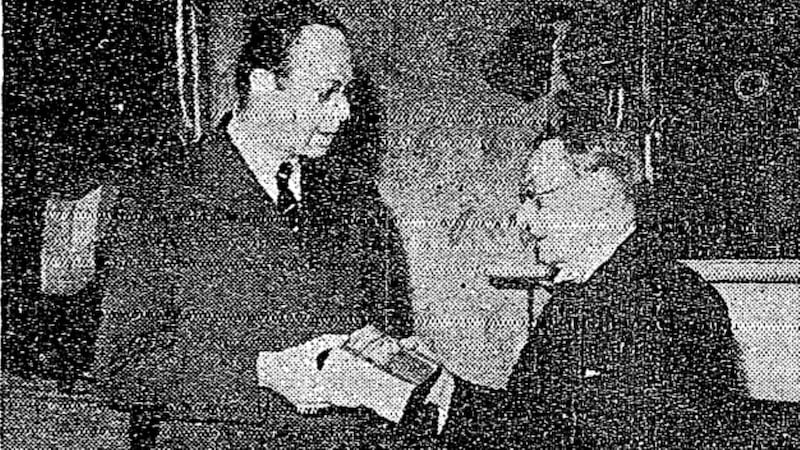During a rushed visit to Castlebar recently, I did not have time to notice one of the town's more unusual addresses: Sir Ernst Chain Road. But by what now looks like a pleasant coincidence, that very same day, it featured in a letter to this newspaper from one Julia Chain, in London.
This "Chain letter", as the headline aptly read, reminded us that Sir Ernst was a joint winner of the 1945 Nobel Prize for physiology or medicine, alongside Howard Florey and Alexander Fleming, for their work on penicillin.
A German-born Jew, he had escaped the Nazis to England. But in later life – perhaps, like so many Germans, having read Heinrich Böll's Irish Journal – he fell in love with the west of Ireland and spent his last years in a cottage at Mulranny, Co Mayo, before dying at Castlebar General Hospital in 1979.

Although he played a vital role in the medical revolution wrought by penicillin, Fleming's was not the lead part that posterity has thrust upon him
Hence his commemoration via the road. It’s a link road (naturally), not far from the railway station to which I ran in a lather of sweat that day, before only just catching the last train back to Dublin.
Anyway, continuing the chain theme, that letter to the editor in turn inspired one to me from Eimer Philbin Bowman, which included a cutting of a book review she wrote for this newspaper in 1984, headlined (at her suggestion): “How penicillin discovered Alexander Fleming.”
The point of her review, and one of the points of the book (“Alexander Fleming: The Man and the Myth,” by Gwen MacFarlane) was that, although he played a vital role in the medical revolution wrought by penicillin, Fleming’s was not the lead part that posterity has thrust upon him.
The true story in short is that he first chanced on the discovery in 1928 when, before going on holidays, he mistakenly left a culture plate on his desk instead of in an incubator. The plate was inoculated with bacteria. While he was away, an airborne mould spore landed on it. And when he returned, he noticed the bacteria had grown everywhere except where the mould was. Thinking “that’s funny”, he went on to name, and perform experiments with, penicillin. But after 18 months or so, he abandoned it as unpromising. In the meantime, to his credit, he had shared samples with other scientists, including the Australian Florey, at Oxford University.
Just over a decade later, Florey and his team (including Chain) carried out a breakthrough experiment with eight white mice. All were injected with virulent streptococci, but four were also given penicillin. By next day, only the ones with penicillin were still alive.
Within two years, the team was also conducting successful clinical trials on humans. Those treated experimentally included a seriously ill friend of Fleming’s, who duly recovered: a “miracle cure” amplified by the Fleet Street press.
Thus, as Philbin Bowman summarised: “Penicillin discovered Alexander Fleming not once but twice”. The involvement of his friend propelled Fleming himself into the spotlight, getting the glory for something he hadn’t altogether earned.
Yes, Florey and Chain shared the Nobel, but most of the fame went to a man who some in Oxford thought was “dead” before he turned up at the laboratory after hearing of the mice experiment.
In fairness to Fleming, a modest and likeable Scotsman, he did not actively seek the fame and even dubbed it the “Fleming myth”. His notoriety arose from a combination of admirers in Fleet Street bigging up the story and the hospital where he had done his earlier experiments, St Mary’s Paddington, maximising the publicity.
The Mayo link this time is that, as a young army officer home on leave in 1915, Fleming married a nurse from Killala, Sarah 'Sareen' McElroy
But getting back to Castlebar, the reason I was there that day was to visit (for the last time, it turned out) my friend Steve Dunford, who has since died. Although Steve was born in Castlebar, he spent most of his later life in Killala, which was the subject of his last book, a copy of which he presented me before I left.
And in an odd twist, as I found out only after reading Eimer’s letter, Fleming also features prominently in Steve’s book. No, it has nothing to do with Ernst Chain, although it does support my suspicion that everything is connected in the end.
The Mayo link this time is that, as a young army officer home on leave in 1915, Fleming married a nurse from Killala, Sarah “Sareen” McElroy. Her drive and energy proved a huge influence on the shy Scot. Having set up her own nursing home in London, for example, she sold it to help ensure he could devote himself to science.
But they also had a son together, Robert (1924-2015), who later became a doctor. He first visited Killala as a child. When he returned in 2001, aptly, it was to unveil bronze busts of both his parents.









